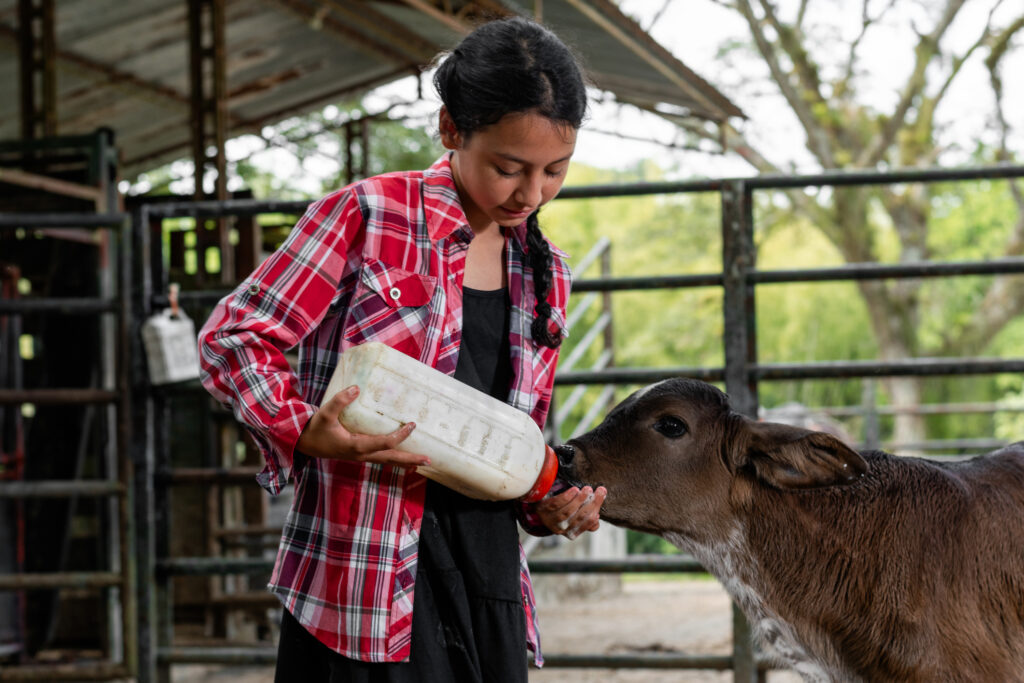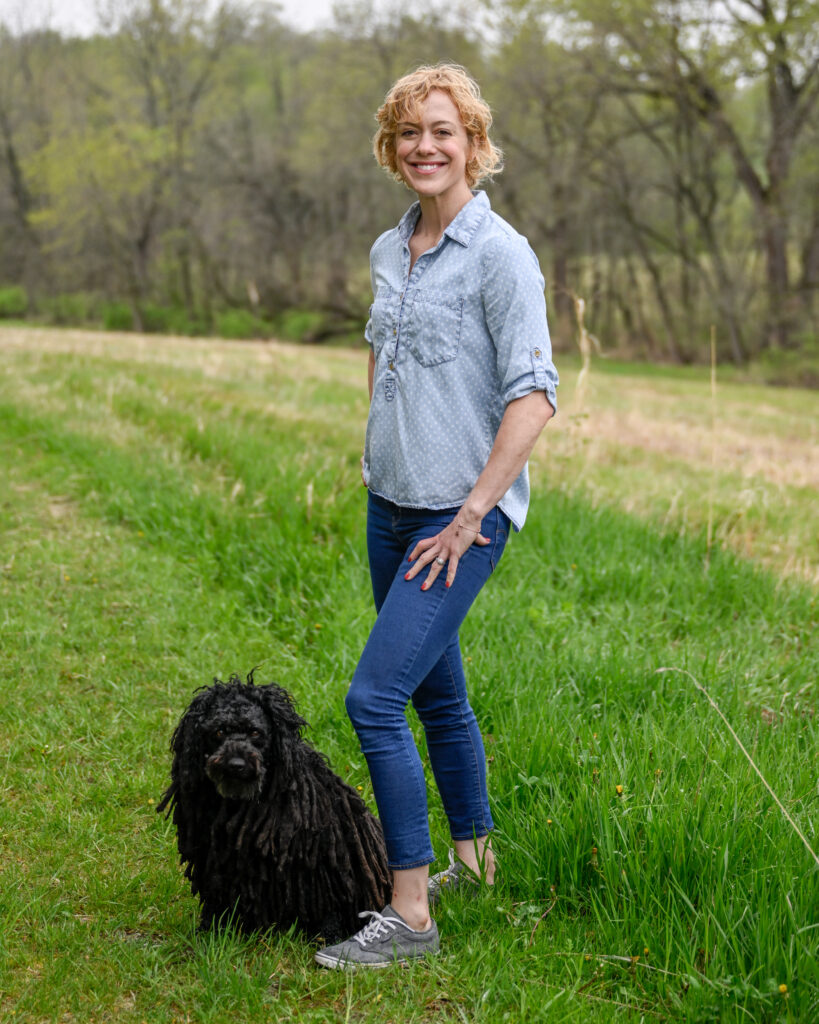Published November 10, 2025
On November 18, University of Iowa Health Care Stead Family Children’s Hospital will mark the 6th annual National Injury Prevention Day (NIPD) by lighting the hospital green to raise awareness about injury prevention and promote ways to keep children and families safe across Iowa.
This year, Jenna Gibbs, MPH, PhD, is leading the hospital’s NIPD activities as its new program manager for injury prevention and outreach. Gibbs is an industrial hygienist specializing in agricultural health and safety. She previously worked at the Great Plains Center for Agricultural Health within the University of Iowa College of Public Health, as well as at the Ag Health and Safety Alliance™, a non-profit organization dedicated to protecting the safety and health of the next generation in agriculture.
Gibbs said the Stead Family Children’s Hospital is uniquely positioned to serve rural and agricultural communities through research and programming focused on topics such as lawn mower and all-terrain vehicle (ATV) safety.
“When I’m in meetings on the twelfth floor, I’m always looking out the window reflecting on the ‘America Needs Farmers’ (ANF) logo and the Hawkeye Wave in nearby Kinnick Stadium,” she said. “It all resonates so much with me, my agricultural background, and all that we want to accomplish at the hospital. It feels like everything really comes together, right here, in this location.”
Below, Gibbs discusses the importance of assigning farm chores that are appropriate for a child’s age and abilities, the need to balance safety with real-world farm experiences, and the role of the Children’s Hospital in promoting safety in rural communities, including during National Injury Prevention Day.

Can you describe an experience you had collaborating with rural and agricultural families?
For seven years, I worked primarily to perform outreach and programs for rural and agricultural communities through the Gear Up for Ag Health and Safety Program.™ I learned how to better advocate for rural and farm families since the program targeted 18–25-year-old young adults working on family, university, or college-run farms. I worked with Carolyn Sheridan, RN, BSN, a nurse from Spencer, Iowa, who has been doing this type of work for more than three decades.
During my time at the Ag Health and Safety Alliance, the program reached more than 5,500 young adults. I also learned about the need to train the next generation on agricultural hazards in a way that also facilitated actual experience working on farms.
What challenge does pediatric agricultural safety currently face?
It’s important to balance youth getting real-world experiences on the farm with the prevention of unnecessary hazards, and that line of risk vs. reward can sometimes be difficult to figure out.
We aren’t aiming to shelter youth from development, but we do care about their health and well-being. Children, intermediate youth, and teens are integrated into both farm chores and rural leisure activities at very young ages. This is a big part of their life experience.
What is one thing parents can do to keep children safer on the farm?
If a child has already been allowed to participate in certain tasks too early, like operating an ATV or UTV for farm purposes, it can sometimes be even more challenging for parents to ‘walk back’ that privilege without it feeling like punishment. Therefore, it’s important for parents, early on, to set expectations for safety, like age-appropriate use of farm vehicles and respect for farm equipment.
In my previous role, I provided input to the Ag Youth Work Guidelines (cultivatesafety.org), a resource designed to help parents and supervisors assign agricultural work and chores that are age- and ability-appropriate. I support the core philosophy that many rural and agricultural youth get injured because they may be performing tasks beyond their development.

How does the Children’s Hospital promote the prevention of agricultural injuries?
In the past decade, the Children’s Hospital has maintained a steady and committed focus to rural and agricultural safety, with a strong focus on research and programs looking at ATV/UTVs behaviors and safety programs, lawn mower safety, rural mental health programs, and safe gun storage.
A few weeks ago, I attended my first STARs ATV/UTV safety program with 200 middle school students in central Iowa. Over the last 15 years, this program has successfully reached more than 70,000 middle and high school students in rural and agricultural locations around our state. To me, that’s just wild. If we could combine these programs with the real impact of dissemination of protective equipment, like the newest-model ATV helmet, we could change safety culture in our state.
How will the Children’s Hospital mark National Injury Prevention Day?
This day is dedicated to raising awareness about the burden of injury and promoting ways to keep children safe. The signature color for this national effort is bright green to symbolize health, growth, and safety—principles that are important to the work being done at the Stead Family Children’s Hospital.
In fact, on November 18, multiple buildings across the University of Iowa campus will be lit green during the evening, including the Children’s Hospital and the student’s union (Iowa Memorial Union). Many cities are making proclamations in support of this day. Our Safety Store at the Children’s Hospital will be hosting an interactive game that promotes education and awareness for hospital visitors.
What are you looking forward to in your new role?
I am excited to bring my agricultural experience to injury program management at the Children’s Hospital. As the only Level 1 pediatric trauma center in the state of Iowa, the Stead Family Children’s Hospital embraces our mission to reduce the burden of injury, which remains the leading cause of death for children in the United States.
Although only 10 counties in Iowa make up over half the state’s population, I know our state is still predominantly rural and it’s a big part of our identify. I now must shift my perspective from young adult farmers to the entire youth age spectrum, including toddlers and newborn infants.
Some resources:
- Childhood injuries
- A spotlight on rural child injuries
- Safety education (UI Health Care Stead Family Children’s Hospital)
- ATV safety and youth (UI IPRC blog)
- ATV safety basics (UI Health Care Stead Family Children’s Hospital)
- Safer gun storage to prevent child injuries and deaths (UI IPRC blog post)
- Serious child injuries from lawn mowers (UI IRPC blog)
- Lawn mower safety tips (UI Health Care Stead Family Children’s Hospital)
- Rural Injury Resource Hub
- Information about the STARs program